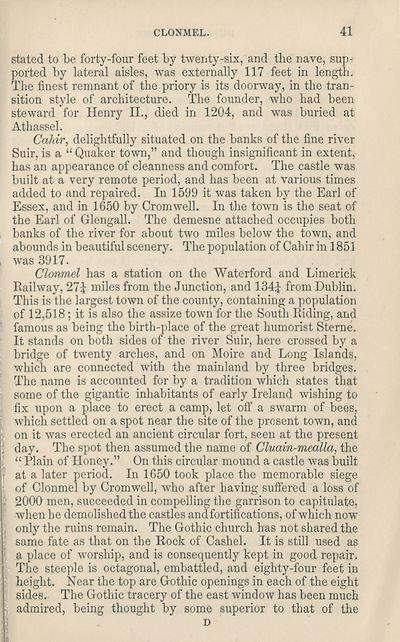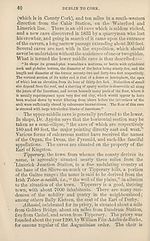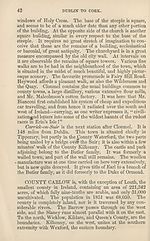Download files
Complete book:
Individual page:
Thumbnail gallery: Grid view | List view

CLONMEL.
41
stated to be forty-four feet by twenty-six, and the nave, sup¬
ported by lateral aisles, was externally 117 feet in length.
The finest remnant of the priory is its doorway, in the tran¬
sition style of architecture. The founder, who had been
steward for Henry II., died in 1204, and was buried at
Athassel.
Cahir, delightfully situated on the banks of the fine river
Suir, is a “ Quaker town,” and though insignificant in extent,
has an appearance of cleanness and comfort. The castle was
built at a very remote period, and has been at various times
added to and repaired. In 1599 it was taken by the Earl of
Essex, and in 1650 by Cromwell. In the town is the seat of
the Earl of Glengall. The demesne attached occupies both
banks of the river for about two miles below the town, and
abounds in beautiful scenery. The population of Cahir in 1851
was 3917.
Clonmel has a station on the Waterford and Limerick
Railway, 27i miles from the Junction, and 134J from Dublin.
This is the largest town of the county, containing a population
of 12,518; it is also the assize town for the South Riding, and
famous as being the birth-place of the great humorist Sterne.
It stands on both sides of the river Suir, here crossed by a
bridge of twenty arches, and on Moire and Long Islands,
which are connected with the mainland by three bridges.
The name is accounted for by a tradition which states that
some of the gigantic inhabitants of early Ireland wishing to
fix upon a place to erect a camp, let off a swarm of bees,
which settled on a spot near the site of the present town, and
on it was erected an ancient circular fort, seen at the present
day. The spot then assumed the name of Cluain-mealla, the
“ Plain of Honey.” On this circular mound a castle was built
at a later period. In 1650 took place the memorable siege
of Clonmel by Cromwell, who after having suflered a loss of
2000 men, succeeded in compelling the garrison to capitulate,
when he demolished the castles and fortifications, of which now
only the ruins remain. The Gothic church has not shared the
same fate as that on the Rock of Cashel. It is still used as
a place of worship, and is consequently kept in good repair.
The steeple is octagonal, embattled, and eighty-four feet in
height. Near the top are Gothic openings in each of the eight
sides. The Gothic tracery of the east window has been much
admired, being thought by some superior to that of the
D
41
stated to be forty-four feet by twenty-six, and the nave, sup¬
ported by lateral aisles, was externally 117 feet in length.
The finest remnant of the priory is its doorway, in the tran¬
sition style of architecture. The founder, who had been
steward for Henry II., died in 1204, and was buried at
Athassel.
Cahir, delightfully situated on the banks of the fine river
Suir, is a “ Quaker town,” and though insignificant in extent,
has an appearance of cleanness and comfort. The castle was
built at a very remote period, and has been at various times
added to and repaired. In 1599 it was taken by the Earl of
Essex, and in 1650 by Cromwell. In the town is the seat of
the Earl of Glengall. The demesne attached occupies both
banks of the river for about two miles below the town, and
abounds in beautiful scenery. The population of Cahir in 1851
was 3917.
Clonmel has a station on the Waterford and Limerick
Railway, 27i miles from the Junction, and 134J from Dublin.
This is the largest town of the county, containing a population
of 12,518; it is also the assize town for the South Riding, and
famous as being the birth-place of the great humorist Sterne.
It stands on both sides of the river Suir, here crossed by a
bridge of twenty arches, and on Moire and Long Islands,
which are connected with the mainland by three bridges.
The name is accounted for by a tradition which states that
some of the gigantic inhabitants of early Ireland wishing to
fix upon a place to erect a camp, let off a swarm of bees,
which settled on a spot near the site of the present town, and
on it was erected an ancient circular fort, seen at the present
day. The spot then assumed the name of Cluain-mealla, the
“ Plain of Honey.” On this circular mound a castle was built
at a later period. In 1650 took place the memorable siege
of Clonmel by Cromwell, who after having suflered a loss of
2000 men, succeeded in compelling the garrison to capitulate,
when he demolished the castles and fortifications, of which now
only the ruins remain. The Gothic church has not shared the
same fate as that on the Rock of Cashel. It is still used as
a place of worship, and is consequently kept in good repair.
The steeple is octagonal, embattled, and eighty-four feet in
height. Near the top are Gothic openings in each of the eight
sides. The Gothic tracery of the east window has been much
admired, being thought by some superior to that of the
D
Set display mode to:
![]() Universal Viewer |
Universal Viewer | ![]() Mirador |
Large image | Transcription
Mirador |
Large image | Transcription
| Antiquarian books of Scotland > Ireland/Irish > Black's guide to Killarney and the south of Ireland > (49) |
|---|
| Permanent URL | https://digital.nls.uk/118861256 |
|---|
| Description | Thousands of printed books from the Antiquarian Books of Scotland collection which dates from 1641 to the 1980s. The collection consists of 14,800 books which were published in Scotland or have a Scottish connection, e.g. through the author, printer or owner. Subjects covered include sport, education, diseases, adventure, occupations, Jacobites, politics and religion. Among the 29 languages represented are English, Gaelic, Italian, French, Russian and Swedish. |
|---|

